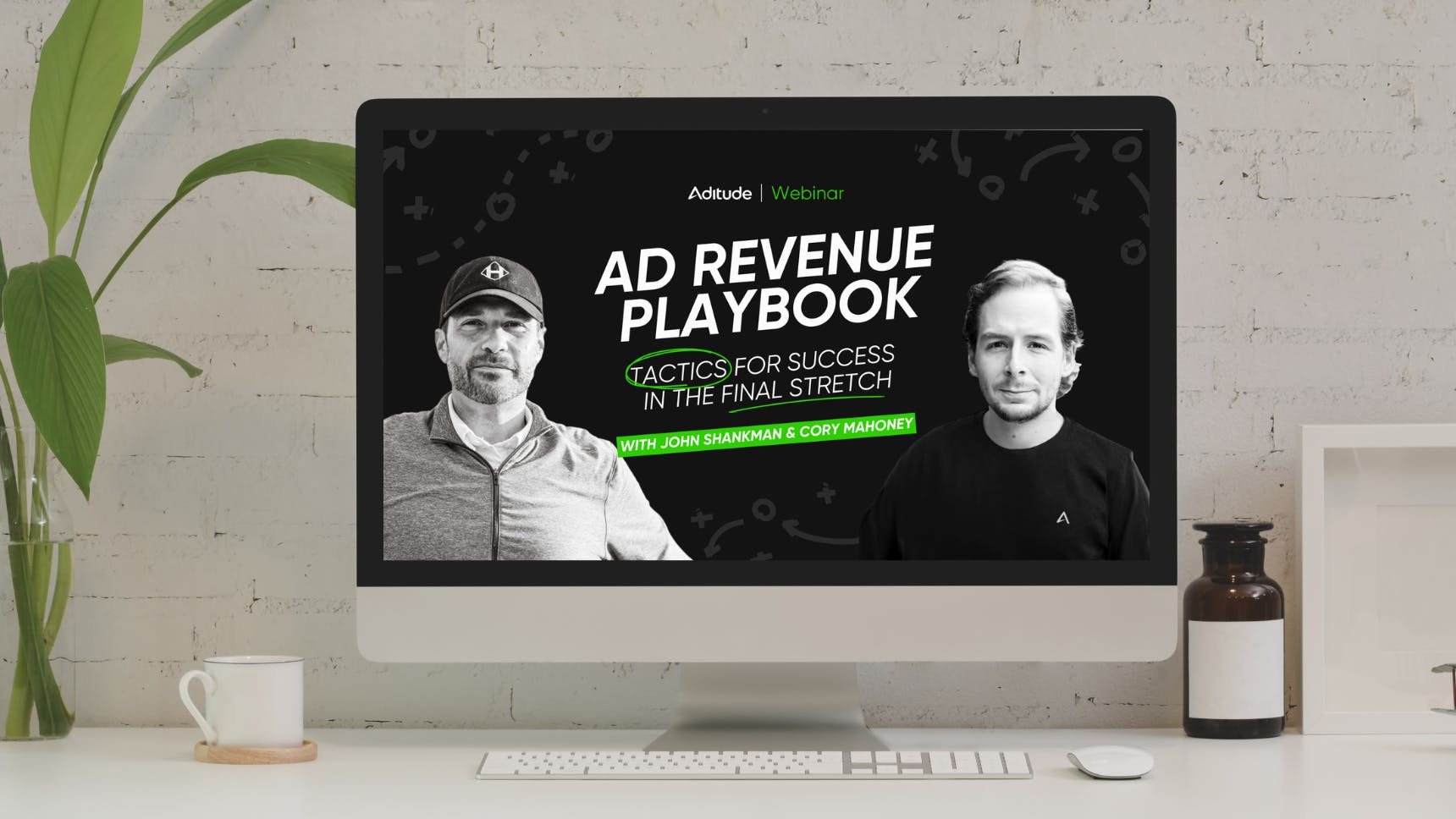Maximize Q4 Ad Revenue: 6 Proven Strategies for Publishers
Maximize your Q4 ad revenue with these 6 proven strategies, including dynamic flooring, bid caching, and optimized refresh settings. Perfect for publishers aiming to capture high CPMs during Q4.

For publishers, Q4 is often the most lucrative time of the year. With global events like Black Friday, Cyber Monday, the holiday shopping season, and even Amazon Prime Day in October, there’s a surge in advertiser demand and consumer spending. This is the perfect opportunity for publishers to fine-tune their ad strategies to capture the highest possible revenue.
However, for many, this period also brings a sense of hesitation—fearing that any tweaks to their ad setups might negatively impact performance at a critical time. Fortunately, there are incremental optimizations you can make that don't require a major overhaul of your ad tech stack and will allow you to boost revenue while mitigating risks.
In a recent webinar, Ad Revenue Playbook: Tactics for Success in the Final Stretch, we outlined six key strategies that have proven to maximize revenue during the high-stakes season of Q4. In this comprehensive guide, we’ll dive deeper into these strategies and show you how you can implement them for maximum impact in Q4.
Why Q4 Matters So Much for Publishers
Before we get into the strategies, it's important to understand why Q4 is so crucial for publishers. Advertisers increase their budgets during this period, targeting consumers who are in the mood to spend. The weeks leading up to Black Friday and Cyber Monday, as well as the extended holiday shopping period, see some of the highest CPMs (cost per thousand impressions) of the year. This influx of demand means more opportunities for publishers to monetize their ad inventory.
However, it’s not just about sitting back and letting the higher CPMs roll in. Publishers need to be proactive to ensure they’re optimizing their setups to attract and secure those high-value bids. That’s where these six strategies come in.
1. Leverage Dynamic Flooring for Competitive Bidding
One of the most impactful ways to maximize your Q4 revenue is by implementing dynamic flooring. At its core, dynamic flooring uses real-time data to adjust the minimum price you’re willing to accept for your ad inventory. This can be particularly powerful in a programmatic landscape where advertisers are constantly bidding for space on your site.
Aditude has been testing dynamic flooring across its network of publishers, and the results have been nothing short of transformative. One publisher saw a 7% revenue lift in November and another saw a 6.5% lift in December, directly as a result of this technique. Additionally, session RPM (revenue per thousand sessions) for one publisher increased by 34%, while eCPM (effective CPM) jumped by 37%.
The beauty of dynamic flooring is that it can push demand partners like Google and prebid partners to pay more for the same inventory. It’s especially effective when paired with prebid flooring, which applies the same concept to your prebid auctions. By simultaneously leveraging both, you increase competition for your ad spaces, which drives up prices.
Not working with Aditude’s Cloud Wrapper? No problem. Aditude offers dynamic flooring as a standalone solution, allowing publishers to take advantage of its benefits without adopting the entire wrapper technology. In Q4, with higher CPMs already in play, using dynamic flooring will further boost your bottom line.
How to Implement Dynamic Flooring
- Step 1: Start by analyzing your current CPMs across different partners. Identify trends and areas where CPMs could be pushed higher.
- Step 2: Implement dynamic flooring technology to raise minimum bid floors in real-time.
- Step 3: Use tools like Aditude Insights to track performance and adjust floors based on demand trends.
- Step 4: Keep an eye on session RPMs and eCPMs to ensure you're driving value without sacrificing too many impressions.
2. Optimize Ad Refresh Settings for Viewability and Revenue
Ad refreshes might seem like a straightforward way to increase impressions, but optimizing the way your ads are refreshed can significantly improve performance. During the busy Q4 period, this can be especially important. There are a few advanced refresh strategies that can help publishers make the most of the increased traffic and advertiser demand:
- Geo Refresh: Not all geographic regions are equal in terms of the ad revenue they generate. For instance, visitors from high-value geos like the US, UK, or Australia tend to attract higher bids. By using geo-based refresh settings, you can prioritize ad refreshes for users in these regions, ensuring that you’re driving the highest-value impressions.
- Dynamic Time to Refresh: Different websites experience traffic spikes at different times. For example, a news site might see a surge in visitors in the morning, while a lifestyle blog might peak in the evening. Dynamic time-to-refresh settings allow you to optimize your ad refresh rates based on traffic patterns, ensuring that you’re refreshing ads when your audience is most engaged.
This approach prevents you from refreshing too frequently (which can hurt viewability) or too infrequently (which can leave money on the table). With Q4’s surge in traffic, this adjustment could make a big difference in revenue.
How to Optimize Refresh Settings
- Step 1: Identify high-value geos in your traffic and adjust your refresh settings to prioritize those regions.
- Step 2: Analyze your traffic patterns and set dynamic refresh timings that align with your peak traffic times.
- Step 3: Test and tweak your refresh rates regularly to ensure they are maximizing impressions without negatively affecting viewability.
3. Implement Bid Caching for Increased Efficiency
Bid caching is another advanced tactic that can be a game-changer during Q4. The idea behind bid caching is simple: when a high-value bid is not used on one ad unit, you can reuse it for other units on the same page. This ensures that no high-value bids are wasted, maximizing the revenue potential for each page view.
This strategy works across both Prebid and Amazon auctions, which cover a large portion of the programmatic landscape. For publishers, it means getting the most out of every bid placed on their inventory.
How to Use Bid Caching
- Step 1: Implement bid caching through your Prebid or Amazon setups.
- Step 2: Ensure that cached bids are being reused across multiple ad units on the same page.
- Step 3: Monitor the performance of your cached bids to ensure they’re driving increased revenue without sacrificing user experience.
4. Expand Your Demand Partners
One mistake that many publishers make is focusing solely on their ad tech stack without paying attention to demand partners. While having the right tech is essential, the partners who are actually bidding on your inventory are just as important.
The merger between Aditude and Hashtag Labs has made it easier than ever for publishers to connect with premium demand partners. For instance, working with partners like Concert, a premium ad network run by Vox Media, can lead to significantly higher bids than more generalized networks.
When expanding your demand partner pool, it's crucial to ensure that these partners are aligned with your inventory and audience. This can increase competition for your ad spaces and drive up CPMs during Q4 when advertisers are looking for premium placements.
How to Expand Your Demand Partners
- Step 1: Evaluate your current demand partners and identify gaps where premium partners could be added.
- Step 2: Use tools like HTL Bid to integrate new partners without adding latency.
- Step 3: Continuously monitor your demand partners' performance to ensure they’re providing value, and adjust your partner stack as needed.
5. Regularly A/B Test Your Ad Configurations
A/B testing is critical to understanding what works best for your site. Q4 presents an excellent opportunity to run A/B tests to fine-tune your ad configurations. Whether it’s testing lazy loading, bidder setups, or refresh settings, A/B testing allows you to see the impact of various configurations on revenue without risking your entire inventory.
One of the biggest advantages of working with a platform like HTL Bid is that it allows for quick, no-code A/B testing. This means publishers can test different setups on a small portion of their traffic, measure the results, and implement changes quickly—something that’s essential during a fast-paced season like Q4.
How to A/B Test for Maximum Impact
- Step 1: Choose a configuration to test, such as lazy loading or refresh timing.
- Step 2: Use HTL Bid’s A/B testing tools to run the test on a small percentage of your traffic or reach out to Aditude to set up an A/B test.
- Step 3: Analyze the results to determine which configuration performs better in terms of CPMs, viewability, and user experience.
- Step 4: Implement the winning configuration across your site and continue testing new ideas.
6. Maximize Viewability and Ad Density
In Q4, maximizing the viewability of your ads can lead to a significant boost in revenue. Advertisers are willing to pay more for inventory that meets high viewability standards, as it ensures their ads are seen by engaged users.
One way to increase viewability is through viewable refreshes, where ads are only refreshed when they’re in view. This ensures that you’re not just serving more impressions but that those impressions are likely to be seen and engaged with. Aditude’s tools make it easy to configure viewable refreshes, and with the combination of HTL Bid and Aditude Insights, you can track the performance of these refresh settings in real-time.
In addition to viewability, increasing ad density—the number of ad units per page—can also help capture more revenue. Multi-format ads, which allow for a mix of video, display, and native ads on the same page, can further increase the value of your inventory.
How to Maximize Viewability and Ad Density
- Step 1: Implement viewable refreshes to ensure that ads are only refreshed when they’re in view.
- Step 2: Experiment with multi-format ads to increase ad density and capture more high-value impressions.
- Step 3: Monitor viewability metrics and adjust refresh settings as needed to ensure you’re meeting advertiser expectations.
Conclusion: Don’t Miss Out on Q4 Opportunities
Q4 is a critical time for publishers to optimize their ad setups and capture the surge in advertiser demand. By implementing these six strategies—dynamic flooring, smart ad refresh settings, bid caching, expanding demand partners, A/B testing, and maximizing viewability—you can significantly increase your revenue without disrupting your site’s performance.
The key to success during Q4 is being proactive and nimble. Tools like HTL Bid and Aditude Insights give you the flexibility to make quick, incremental changes that can have a big impact on your bottom line. Don’t wait until it’s too late—start testing and optimizing now to make the most of Q4’s revenue potential.
For more insights or to explore these strategies further, feel free to reach out to the Aditude team for a demo and learn how you can set your site up for success this holiday season.




